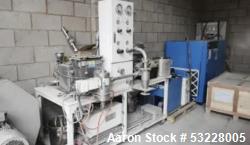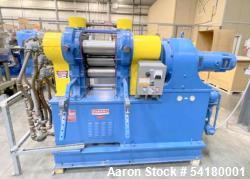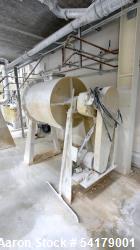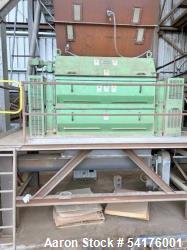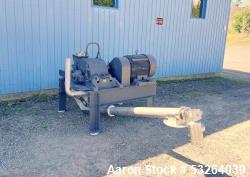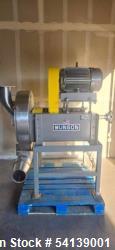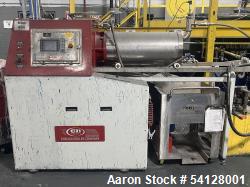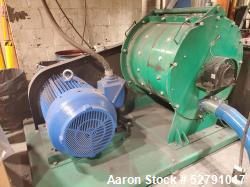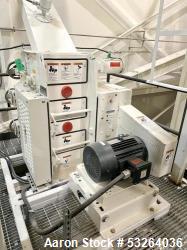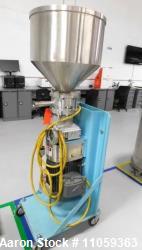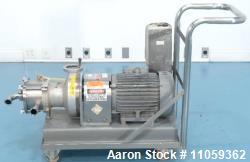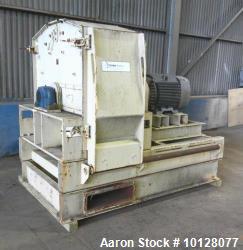Used Industrial Mills & Milling Machines
Aaron Equipment Company has a large inventory of reconditioned, unused, and used mills. Browse our inventory of available used milling machines and request a quote today. Mills and milling processes are used for breaking down, separating, sizing, or classifying bulk materials. Mills can also be used to remove contamination or water moisture from bulk materials to produce dry particles. Mills allow you to control the particle size to be used in the manufacturing process which can enhance product flow rate and improve the downstream process. Ball mills, colloid mills, Fitzmills, an pellet mills are a few of the common mills used in various manufacturing facilities. If you are looking to sell your used mill submit a request online or contact Erik Eichert at 630-238-7480.
Mills Pay The Bills: Everything a buyer should know about industrial mills including 2 roll mills, 3 roll mills, hammermills, colloid mills and sand and media mills.
When it comes to industrial mills, understanding the different types and their applications can be crucial for making the right purchasing decision. Mills are used across various industries for processing materials, and each type has its unique benefits and uses. In this guide, we’ll explore everything a buyer should know about industrial mills, including 2 roll mills, 3 roll mills, hammermills, colloid mills, and sand and media mills.
Understanding Industrial Mills
Industrial mills are machines that reduce solid materials into smaller pieces by grinding, crushing, or cutting. They are essential in industries such as food processing, pharmaceuticals, cosmetics, chemicals, and more. The choice of mill depends on the product being processed, the desired outcome, and the specific requirements of your operation.
Types of Industrial Mills
Here's a closer look at the primary types of industrial mills and their applications:
- 2 Roll Mills are commonly used for mixing and blending materials. These mills consist of two horizontally placed rolls that rotate in opposite directions. The material is fed into the gap between the rolls, where it is compressed and sheared. This type of mill is widely used in rubber, plastics, and related industries for its ability to produce uniform blends.
- Applications: Mixing polymers, rubber compounding, and plastic blending.
- 3 Roll Mills are used for refining and dispersing materials. They consist of three horizontally placed rolls, where the material passes through two gaps formed by the rolls. These mills are highly efficient for achieving a fine dispersion of pigments, inks, and other substances.
- Applications: Ink manufacturing, paint production, and cosmetic formulations.
- Hammermills are versatile machines used for grinding, shredding, and pulverizing materials. They use a series of hammers that are mounted on a rotating shaft. As the shaft spins, the hammers strike the material, breaking it down into smaller pieces. These mills are ideal for coarse and fine grinding tasks.
- Applications: Animal feed production, waste reduction, and biomass processing.
- Colloid Mills are used for reducing particle size and creating emulsions. They work by passing the material through a narrow gap between a rotating rotor and a stationary stator. This action generates high shear forces that break down the particles. Colloid mills are commonly used in the food, pharmaceutical, and cosmetic industries.
- Applications: Mayonnaise production, pharmaceutical creams, and lotions.
- Sand and Media Mills are used for fine grinding and dispersion. They operate by using a grinding media, such as sand, glass beads, or ceramic balls, to achieve particle size reduction. These mills are effective for producing ultra-fine particles and are widely used in the paint, ink, and coatings industries.
- Applications: Paint manufacturing, ink production, and coatings development.
Factors to Consider When Buying Industrial Mills
When selecting an industrial mill, there are several factors to consider to ensure that you choose the right industrial mill for your needs:
- Material Characteristics: Understanding the properties of the material you intend to process is crucial. Consider factors such as hardness, abrasiveness, moisture content, and temperature sensitivity. These characteristics will influence the type of mill best suited for your application.
- Desired Particle Size: The required particle size and distribution play a significant role in mill selection. Some mills are better suited for coarse grinding, while others excel in producing fine or ultra-fine particles. Define your end product specifications to guide your decision.
- Production Capacity: Consider the volume of material you need to process. Industrial mills come in various sizes and capacities, so it's important to choose one that can handle your production demands. Overloading a mill can lead to inefficiencies and increased wear.
- Maintenance and Operating Costs: Evaluate the maintenance requirements and operating costs associated with each type of mill. Some mills require more frequent maintenance and have higher energy consumption. Balancing upfront costs with long-term operational expenses is essential for a cost-effective investment.
- Safety and Compliance: Ensure that the mill you choose complies with industry standards and safety regulations. Proper safety features and compliance with regulations are crucial to protect your employees and maintain a safe working environment.
Advantages of Different Industrial Mill Types
Each type of industrial mill offers distinct advantages:
- 2 Roll Mills: Ideal for blending and mixing, providing uniform consistency.
- 3 Roll Mills: Excellent for fine dispersion, achieving smooth and even mixtures.
- Hammermills: Versatile for various materials, suitable for both coarse and fine grinding.
- Colloid Mills: Effective for emulsifying and reducing particle size, creating stable mixtures.
- Sand and Media Mills: Efficient for ultra-fine grinding, producing high-quality dispersions.
Selecting the right industrial mill is a critical decision that impacts your production process and final product quality. By understanding the different types of mills and their specific applications, you can make an informed choice that aligns with your operational needs. Remember to consider factors such as material characteristics, desired particle size, production capacity, maintenance, and safety when evaluating your options. With the right mill, you can enhance efficiency, achieve the desired product quality, and optimize your production processes. Industrial mills are powerful tools that, when selected correctly, can drive your business success. Whether you're in pharmaceuticals, food processing, or any other industry, this guide equips you with the knowledge to make a wise investment.
